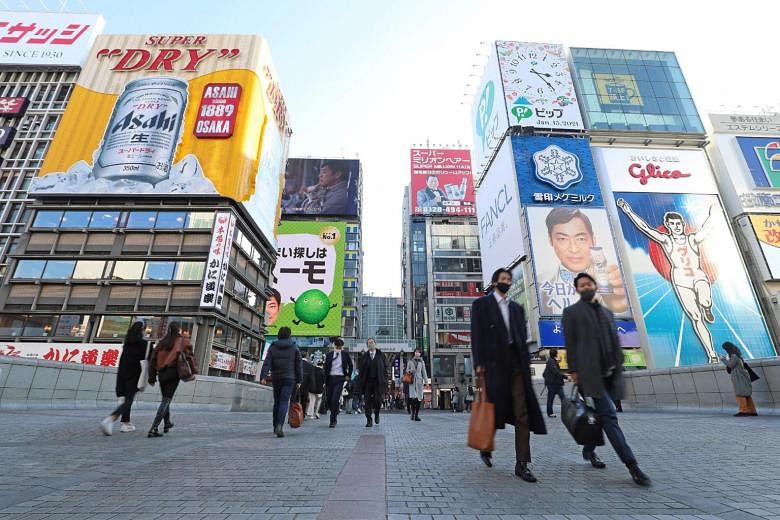TOKYO - Japan has expanded its Covid-19 state of emergency to seven more prefectures, covering the major cities of Osaka, Nagoya, Kobe and Fukuoka, in a bid to curb the spread of the coronavirus nationwide.
The measure, announced on Wednesday (Jan 13), takes effect at midnight. These seven areas join Tokyo and three neighbouring prefectures, where the emergency came into force last Friday in the declaration that lasts until Feb 7.
To fight the surge in cases, Japan on Wednesday also enacted a blanket entry ban on all non-resident foreign nationals until Feb 7. This covers the 11 regions with which Japan has established business track arrangements, including China, Singapore and South Korea.
"We need people to seriously rethink their actions, especially youth in their 20s or 30s who form the largest group of infections. Many may be asymptomatic and going out without realising they are spreading the virus," Prime Minister Yoshihide Suga told a news conference.
"This is the reality that we face now," he said, adding that it was critical to send a strong message in persuading people to change their behaviour.
The measure came as Japan registered at least 97 Covid-19 deaths on Wednesday, the highest single-day toll thus far. The number of patients in serious condition rose to a new high of 900, while at least 5,845 fresh infections were logged nationwide.
Japan Medical Association President Toshio Nakagawa, in a separate news conference, said the government should not hesitate to consider a national emergency, noting that hospitals are already overburdened to the point of collapse.
Still, economy minister Yasutoshi Nishimura, Japan's point man for Covid-19 strategy, told Parliament that there was no plan to extend the emergency declaration nationwide.
On Wednesday, Japan crossed the 300,000 mark in total number of infections. It had taken 50 days for the tally to climb from 100,000 to 200,000, but just 23 days to surge past 300,000.
The latest measure places 11 out of Japan's 47 prefectures under a state of emergency, covering a total of 70.2 million people or 55.9 per cent of the overall population.
It was enacted last Friday in Tokyo, Chiba, Saitama and Kanagawa, and has been expanded to cover Tochigi, Gifu, Aichi (where Nagoya is located), Osaka, Kyoto, Hyogo (where Kobe is situated), and Fukuoka.
Separately, Miyazaki and Kumamoto prefectures on the south-western island of Kyushu have issued their own emergency declarations. Mie, in central Japan, is set to follow suit today.
These are not legally binding - unlike the national decree - but bypasses the bureaucracy involved. Local leaders said it was necessary to emphasise the Covid-19 health risks.
Despite the deteriorating Covid-19 situation and the fast waning support for the Olympic Games this year, top government spokesman Katsunobu Kato said on Wednesday that Japan was continuing preparations for the Games this summer.
Three separate media polls last weekend showed eight in 10 Japanese were against the Games taking place, while disapproval for Mr Suga's Cabinet exceeded support.
Japan has been relying on people to exercise social responsibility since the pandemic began. But limits to this approach has become more evident, and the government is planning new laws to include punitive measures.
Among the measures being planned are penalties on confirmed Covid-19 patients who refuse to be hospitalised, punishments for those who lie or refuse to answer questions pertaining to epidemiological investigations, and fines on businesses that refuse to heed requested curfews.
Japan also plans to disclose the names of those who breach the 14-day quarantine, as well as revoke foreigners' resident status if they do not quarantine, Kyodo News reported.

The expanded declaration, as is the case in the Greater Tokyo metropolitan area, does not call for the complete closure of any businesses nor the cancellation of any events.
Rather, restaurants and bars are instructed to close by 8pm and stop serving alcohol by 7pm, with the government identifying dining and drinking as "areas of highest risk".
If they do not comply, they may be named and shamed and will not qualify for government subsidies of up to 60,000 yen (S$765) a day.
Other facilities like shopping malls, cinemas and sports gyms are only "urged" to follow the same curfew. Events and concerts can still be held, subject to a maximum limit of 5,000 people or half the venue capacity, whichever is lower.

Mindful of the inevitable economic impact, Mr Suga is hesitant to impose blanket measures under the latest state of emergency.
But it also signals a difficult balancing act. Foot traffic to major hubs like Ginza in Tokyo has not fallen at all during the day - and is as much as four times the traffic when compared to the first state of emergency declared from April 7 to May 25 last year.
Many see the fact that businesses are being kept open during the day as tacit approval to go out. But Tokyo Governor Yuriko Koike warned on Wednesday: "Covid-19 does not follow a clock. It is possible to catch and spread the disease at all hours."
Mr Nishimura added: "We are not saying that it is OK to have meals together during lunchtime. Please work at home as much as possible and have meals at home."












